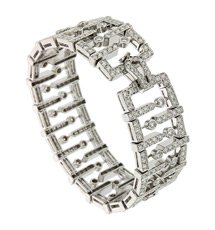Art Deco is an aesthetic that was popular during the 1920, 30s and 40s. It celebrated modernity and innovation, while featuring influences of ancient Greece, Rome and Egypt. Many Art Deco creations are geometric, favoring straight lines and sharp angles. The style influenced everything from architecture, electronics and even jewelry. Someone who loves vintage looks may want to consider an Art Deco influenced diamond engagement ring.
 Step cut diamonds were popular in Art Deco’s heyday. Unlike brilliant diamonds, which use facets to scatter light within a diamond, step cuts use facets parallel to the girdle to highlight the stone’s clarity and luster. Step cut diamonds may be triangular, trapezoidal or kite shaped, but the most iconic are the rectangular cuts. Of these, baguette and emerald cut diamonds are the best known.
Step cut diamonds were popular in Art Deco’s heyday. Unlike brilliant diamonds, which use facets to scatter light within a diamond, step cuts use facets parallel to the girdle to highlight the stone’s clarity and luster. Step cut diamonds may be triangular, trapezoidal or kite shaped, but the most iconic are the rectangular cuts. Of these, baguette and emerald cut diamonds are the best known.
While baguette cut diamonds are often seen on diamond rings today, they often serve to accentuate other diamonds. Baguettes may serve as side stones, embed themselves into the band or serve as a halo for the central jewel. Emerald cut diamonds are often prominently featured on diamond rings instead of being used as an accent. Its broad table and culet show emphasize lines and clarity. An emerald cut engagement ring either plain or with baguette diamonds, and mounted on platinum or white gold will emulate the aesthetics of the mid-1900s.
Clear Emerald Cut Diamonds
Looking Deep Inside the Crystal
Step cut diamonds stand out against brilliant cuts. While the latter is cut to underscore light, step cuts focus on the crystal itself. They’re angular in shape, with parallel facets nested one inside the other. Emerald cut diamonds are the most popular step cuts.
The cut is named for the green gemstone. Emeralds are known for their color, “jardin” or mossy interior, and their fragility. A rectangular cut with cropped corners and broad table facet was created to protect the jewel while displaying its jardin. Cutters started using this technique on other stones such as diamonds.
With reduced brilliance and a broad table, an emerald cut diamond’s clarity comes to the forefront. Those seeking emerald cut engagement rings may want to focus on stones with high clarity grades such as VVS1. Emerald cuts may also be a good choice for jewels with unique clarity characteristics, like a heart shaped cloud. Try looking at multiple stones before choosing.
Color is also highlighted with emerald cuts. Those who enjoy a more classic looking diamond may want to concentrate on jewels with higher color ratings. The color of the precious metals may also influence the apparent color, like yellow gold making a jewel seem whiter.
Ideal emerald cuts should be neither too wide nor too narrow. Recommended length to width ratios are around 1.5:1 to 1.75:1. The sides of the stone should be parallel with one another, and the cropped corners should be even. Most emerald cut diamond bands are set so the length runs down the finger. Designer engagement rings may place the jewel sideways for a standout look.





